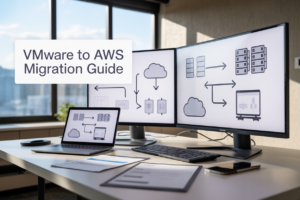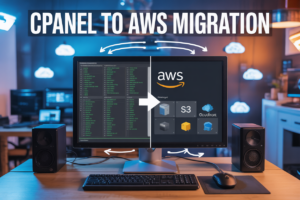Security threats don’t wait for business hours, and manual IP blocking creates dangerous delays that attackers can exploit. AWS Lambda Slack integration solves this problem by creating an automated IP blocking system that responds to threats in seconds, not minutes.
This guide is designed for DevOps engineers, security administrators, and development teams who need to build robust, serverless IP blocking automation without complex infrastructure overhead. You’ll learn how to create a system that detects suspicious activity and blocks malicious IPs instantly through Slack commands.
We’ll walk through setting up your Lambda security automation environment, including the essential AWS services and permissions you need. You’ll also discover how to build a Slack bot IP blocking interface that lets your security team trigger blocks with simple commands. Finally, we’ll cover implementing automated threat response logic that analyzes incoming requests and blocks suspicious IPs before they can cause damage.
By the end, you’ll have a production-ready Lambda security functions system that keeps your infrastructure protected around the clock.
Understanding AWS Lambda and Slack Integration Fundamentals
AWS Lambda serverless architecture benefits for security automation
AWS Lambda stands out as the perfect foundation for building automated security responses because it runs your code without managing servers. When a security threat surfaces, Lambda functions can spring into action within milliseconds, processing threat intelligence and executing countermeasures faster than any manual response team could manage.
The pay-per-execution model makes Lambda security automation incredibly cost-effective. You’re only charged when actual security events trigger your functions, which means your IP blocking system runs virtually free during quiet periods but scales instantly when under attack. This serverless approach eliminates the overhead of maintaining dedicated security servers that sit idle most of the time.
Lambda’s automatic scaling capabilities shine during distributed attacks or high-volume security events. Whether you’re dealing with a single suspicious IP or a coordinated botnet assault involving thousands of addresses, Lambda spawns additional function instances to handle the workload without any configuration changes on your part.
The built-in AWS integration ecosystem accelerates security automation development. Lambda functions connect seamlessly with CloudWatch for monitoring, VPC configurations for network-level blocking, and AWS WAF for application-layer protection. This native integration eliminates the complex middleware typically required when building security systems across different platforms.
Memory and execution time flexibility allows you to optimize your Lambda security functions based on specific blocking requirements. Simple IP validation might need only 128MB of memory, while complex threat analysis could require up to 10GB for processing large security datasets in real-time.
Slack API capabilities for real-time notifications and commands
Slack’s API transforms your security operations by creating interactive command centers where security teams can monitor threats and execute responses without leaving their communication platform. The Real Time Messaging API enables instant notifications when Lambda functions detect suspicious activity, ensuring your team knows about potential threats within seconds of detection.
Slack’s slash commands provide a powerful interface for security operations teams to trigger IP blocking actions manually. Custom commands like /block-ip 192.168.1.100 can instantly execute Lambda functions that add malicious addresses to security group rules or WAF blacklists. This conversational interface makes complex security operations accessible to team members who might not be comfortable with traditional command-line tools.
Interactive components like buttons and dropdown menus enhance security workflows by allowing teams to approve or deny automated blocking recommendations directly within Slack messages. When Lambda detects a potentially malicious IP, it can send a Slack message with “Block” and “Whitelist” buttons, enabling human oversight for edge cases that require judgment calls.
The webhook system creates bidirectional communication between your AWS Lambda security functions and Slack channels. Incoming webhooks push security alerts to designated channels, while outgoing webhooks trigger Lambda functions when team members interact with security messages. This creates a seamless feedback loop where human intelligence enhances automated responses.
Bot users provide persistent identities for your security automation system within Slack workspaces. Rather than generic webhook messages, your IP blocking system can communicate through a dedicated security bot that team members recognize and trust. This branded approach improves adoption and makes security notifications feel integrated rather than external.
Essential prerequisites and account setup requirements
Your AWS account needs specific permissions and configurations before implementing Lambda Slack integration for IP blocking. Start by creating an IAM role with Lambda execution permissions plus additional policies for EC2 security groups, VPC management, and AWS WAF access. This role should include CloudWatch Logs permissions for debugging and monitoring your security automation functions.
The AWS CLI installation on your development machine streamlines Lambda function deployment and testing. Configure your CLI with programmatic access keys that have sufficient permissions to create and manage Lambda functions, API Gateway endpoints, and related AWS resources. Consider using AWS CloudFormation or Terraform templates to maintain consistent environments across development, staging, and production.
Slack workspace administration privileges are required to install custom applications and configure webhooks for your security automation system. Create a dedicated Slack app through the Slack API console, generate bot tokens, and configure OAuth scopes that allow your Lambda functions to post messages, read channel history, and respond to slash commands.
Network connectivity between your AWS environment and Slack’s servers needs consideration, especially if your Lambda functions run within VPC configurations. Ensure NAT gateways or VPC endpoints provide internet access for Slack API calls while maintaining security isolation for your infrastructure.
Development environment preparation includes installing the AWS SDK, Slack SDK, and testing frameworks for your chosen programming language. Python developers should configure boto3 and slack-sdk libraries, while Node.js users need the aws-sdk and @slack/bolt-js packages. Local testing environments should mirror your production Lambda runtime as closely as possible.
Budget allocation for AWS Lambda execution, data transfer, and potential AWS WAF charges ensures your security automation system operates without unexpected costs. Most IP blocking scenarios generate minimal charges, but high-volume attacks could increase execution costs that should be factored into your security budget planning.
Setting Up Your AWS Lambda Environment for IP Blocking
Creating and Configuring Your Lambda Function
Start by navigating to the AWS Lambda console and clicking “Create function.” Choose “Author from scratch” and name your function something descriptive like slack-ip-blocker. Select Python 3.9 or later as your runtime since it offers excellent library support for our AWS Lambda Slack integration requirements.
Configure your function timeout to 30 seconds minimum – automated IP blocking operations can take time when checking multiple security databases. Set memory allocation to at least 512 MB to handle concurrent API calls efficiently.
In the function configuration, enable dead letter queues to capture failed executions. This becomes crucial when your Lambda security automation encounters network issues or API rate limits during critical blocking operations.
Create a deployment package structure with separate folders for your main handler code and utility modules. This organization helps maintain your serverless IP blocking system as it grows in complexity.
Installing Required Python Libraries and Dependencies
Your Lambda security functions need several key Python libraries. Create a requirements.txt file with these essential dependencies:
requests==2.31.0
boto3==1.34.0
slack-sdk==3.23.0
ipaddress==1.0.23
python-dotenv==1.0.0
Use Lambda Layers to manage these dependencies efficiently. Create a layer containing all third-party libraries, which keeps your deployment package lightweight and enables reuse across multiple functions in your automated threat response infrastructure.
Package your dependencies correctly by running pip install -r requirements.txt -t ./python/ in a Linux environment that matches Lambda’s runtime. Zip the entire python directory and upload it as a layer.
For IP geolocation and reputation checking, consider adding specialized libraries like geoip2 or integrate with services like VirusTotal’s API through the vt-py library.
Setting Up IAM Roles and Security Permissions
Create a custom IAM role specifically for your Slack bot IP blocking function. Start with the basic AWSLambdaBasicExecutionRole managed policy for CloudWatch logging capabilities.
Add these specific permissions to your custom policy:
ec2:AuthorizeSecurityGroupIngressandec2:RevokeSecurityGroupIngressfor security group modificationswafv2:UpdateIPSetfor AWS WAF integrationlogs:CreateLogGroup,logs:CreateLogStream, andlogs:PutLogEventsfor detailed loggingssm:GetParameterandssm:GetParametersfor secure parameter retrieval
{
"Version": "2012-10-17",
"Statement": [
"ec2:DescribeSecurityGroups",
"ec2:AuthorizeSecurityGroupIngress",
"ec2:RevokeSecurityGroupIngress"
],
"Resource": "*"
}
]
}
Apply the principle of least privilege by restricting actions to specific resources where possible. Use condition keys to limit operations to certain IP ranges or security groups.
Configuring Environment Variables for Secure API Access
Never hardcode sensitive credentials in your AWS Lambda cybersecurity functions. Use AWS Systems Manager Parameter Store or AWS Secrets Manager for storing sensitive data like Slack tokens and API keys.
Set up these environment variables in your Lambda configuration:
SLACK_BOT_TOKEN: Reference to your encrypted Slack bot tokenSLACK_SIGNING_SECRET: For webhook verificationSECURITY_GROUP_IDS: Comma-separated list of security groups to modifyLOG_LEVEL: Set to “INFO” for production, “DEBUG” for development
For your Lambda Slack webhook integration, create a parameter in Systems Manager:
aws ssm put-parameter \
--name "/lambda/ip-blocker/slack-token" \
--value "xoxb-your-slack-token" \
--type "SecureString" \
--description "Slack bot token for IP blocking automation"
In your Lambda code, retrieve these values using boto3:
import boto3
ssm = boto3.client('ssm')
response = ssm.get_parameter(
Name='/lambda/ip-blocker/slack-token',
WithDecryption=True
)
slack_token = response['Parameter']['Value']
Configure different parameter paths for development, staging, and production environments to maintain proper separation and security across your deployment pipeline.
Implementing Automated IP Detection and Analysis
Monitoring CloudTrail logs for suspicious activity patterns
CloudTrail serves as your AWS account’s digital security camera, recording every API call and action across your infrastructure. When building an automated IP detection system with AWS Lambda, CloudTrail logs become your primary data source for identifying potential threats. Your Lambda function needs to process these logs efficiently to spot patterns that human analysts might miss.
Setting up effective CloudTrail monitoring requires configuring specific event filters that focus on high-risk activities. Failed login attempts, unusual resource access patterns, and API calls from unfamiliar geographic locations should trigger your analysis pipeline. Your AWS Lambda security automation can process these events in near real-time by subscribing to CloudTrail log streams through CloudWatch Events.
Create custom parsing logic that examines source IP addresses, user agents, and request frequencies. Legitimate users typically exhibit predictable behavior patterns, while malicious actors often leave digital fingerprints through rapid-fire requests or attempts to access restricted resources. Your Lambda function should maintain sliding window counters to track request volumes per IP address over different time periods.
Setting up threat intelligence feeds integration
Modern cybersecurity demands external threat intelligence to stay ahead of emerging threats. Your serverless IP blocking system should integrate multiple threat intelligence feeds to enhance detection accuracy. Popular feeds include commercial services like VirusTotal, AlienVault OTX, and government-provided indicators of compromise.
Building feed integration requires establishing secure API connections within your Lambda functions. Store API credentials in AWS Secrets Manager and implement proper error handling for feed unavailability. Your system should cache threat intelligence data in DynamoDB to reduce API calls and improve response times during peak activity periods.
Design your feed integration to support multiple data formats including STIX/TAXII, JSON feeds, and CSV exports. Each feed provider uses different schemas, so create normalization functions that convert threat indicators into a standardized format your analysis engine can process consistently.
Creating custom IP reputation scoring algorithms
Generic blacklists can’t capture the nuanced threat landscape specific to your organization. Developing custom IP reputation scoring provides more accurate threat assessment tailored to your infrastructure and user patterns. Your AWS Lambda cybersecurity functions should implement multi-factor scoring that weighs various risk indicators.
Design scoring algorithms that consider geographic anomalies, behavioral patterns, and historical activity. An IP address from an unexpected country attempting to access sensitive resources should receive higher risk scores than familiar domestic traffic. Implement decay functions that reduce risk scores over time for addresses that demonstrate legitimate behavior.
Your scoring system should maintain separate reputation databases for different service categories. Web application traffic requires different evaluation criteria than API access or administrative functions. Create weighted scoring matrices that adjust risk calculations based on the targeted service and attempted actions.
Establishing automated threat classification rules
Effective automated threat response depends on accurate classification rules that minimize false positives while catching genuine threats. Your Lambda security functions need sophisticated decision trees that evaluate multiple data points before triggering IP blocking actions through your Slack bot interface.
Implement tiered classification levels including “suspicious,” “probable threat,” and “confirmed malicious” categories. Each tier should trigger different response protocols, from enhanced monitoring to immediate blocking. Your automated threat response system should consider confidence levels based on the number of indicators present and their individual reliability scores.
Build exception handling for known good actors like security scanners, monitoring services, and legitimate business partners. Maintain whitelists that prevent accidental blocking of critical services while allowing your system to flag unusual activity from these sources for manual review. Your classification rules should also account for time-based patterns, recognizing that some activities are normal during business hours but suspicious at midnight.
Create feedback loops that allow security analysts to refine classification rules based on real-world results. Your system should track false positive rates and automatically adjust thresholds to maintain optimal balance between security and operational continuity.
Building the Slack Bot Interface for Security Operations
Creating your Slack app and bot user configuration
Setting up your Slack app forms the backbone of your AWS Lambda Slack integration for IP blocking automation. Start by navigating to the Slack API website and creating a new app from scratch. Choose “From an app manifest” if you want to speed up the process with predefined configurations.
Your bot needs specific OAuth scopes to function effectively. Essential scopes include chat:write for sending messages, commands for slash command functionality, im:write for direct messages, and files:write for sharing logs or reports. The app_mentions:read scope enables your bot to respond when mentioned in channels.
Configure your bot user under the “App Home” section. Give it a descriptive name like “SecurityBot” or “IPBlocker” and upload a relevant avatar. Enable the “Always Show My Bot as Online” option to maintain professional appearance during security incidents.
The bot token (starting with xoxb-) serves as your primary authentication method for Lambda security automation. Store this token securely in AWS Systems Manager Parameter Store or AWS Secrets Manager rather than hardcoding it into your Lambda functions.
Designing slash commands for manual IP blocking requests
Slash commands provide security teams with instant access to IP blocking capabilities directly from any Slack channel. Create commands that follow intuitive patterns like /block-ip 192.168.1.100 or /unblock-ip 10.0.0.5.
Design your command structure to accept multiple parameters:
/block-ip [IP_ADDRESS] [DURATION] [REASON]/check-ip [IP_ADDRESS]for status verification/list-blockedto view currently blocked IPs
Each slash command triggers your Lambda security functions through a webhook URL. Configure the request URL to point to your Lambda function’s API Gateway endpoint. The command payload includes user information, channel context, and the complete command text for processing.
Input validation becomes critical at this stage. Your Lambda function should verify IP address formats using regex patterns and validate user permissions before executing blocking operations. Implement rate limiting to prevent command abuse and maintain audit logs for compliance requirements.
Setting up interactive message buttons for approval workflows
Interactive message buttons transform your Slack bot IP blocking system from simple commands into sophisticated approval workflows. When your automated system detects suspicious activity, it can send rich messages with contextual buttons rather than requiring manual command entry.
Create button attachments using Slack’s Block Kit framework. A typical security alert might include:
- “Block Immediately” (danger style, red button)
- “Investigate Further” (primary style, blue button)
- “False Positive” (default style, gray button)
- “View Details” (link button to security dashboard)
Configure each button with unique action_id values and relevant metadata. When users click buttons, Slack sends interactive payloads to your configured endpoint. Your Lambda function processes these interactions and executes the appropriate security actions.
Implement user authorization checks within button handlers. Only security team members should access blocking functions, while read-only users might only view investigation details. Use Slack’s user group APIs to maintain dynamic permission systems.
Configuring webhook endpoints for real-time communication
AWS Lambda cybersecurity implementations rely heavily on webhook endpoints for bidirectional communication between Slack and your security infrastructure. Configure your API Gateway to handle multiple webhook types: slash commands, interactive components, and event subscriptions.
Set up event subscriptions for real-time monitoring. Subscribe to message events in security channels, user join/leave events, and file sharing activities. Your serverless IP blocking system can analyze these events for suspicious patterns and respond automatically.
Configure your Lambda function to handle Slack’s challenge verification process. When setting up URLs, Slack sends a challenge parameter that your function must echo back within three seconds. Implement proper error handling and retry mechanisms for webhook reliability.
Lambda Slack webhook configurations should include:
- Proper CORS headers for browser-based interactions
- Request signature verification using Slack’s signing secret
- Timeout handling for long-running security operations
- Structured logging for debugging webhook issues
Use environment variables to store webhook URLs, signing secrets, and API tokens. This approach enables easy configuration management across development, staging, and production environments while maintaining security best practices for your automated threat response system.
Developing the Core IP Blocking Logic
Integrating with AWS WAF for Web Application Protection
AWS WAF serves as your first line of defense for web applications, and integrating it with your Lambda security automation creates a powerful IP blocking system. The WAF integration allows you to dynamically update IP sets that can block malicious traffic before it reaches your applications.
Your Lambda function needs to interact with the AWS WAF API to create and manage IP sets. Start by creating an IP set in WAF that will contain your blocked IPs. Use the create_ip_set() method with the appropriate scope (REGIONAL or CLOUDFRONT) depending on your architecture.
import boto3
waf_client = boto3.client('wafv2')
def update_waf_ip_set(ip_address, action='block'):
ip_set_name = 'automated-blocked-ips'
# Get current IP set
response = waf_client.get_ip_set(
Name=ip_set_name,
Scope='REGIONAL',
Id='your-ip-set-id'
)
current_addresses = response['IPSet']['Addresses']
if action == 'block' and ip_address not in current_addresses:
current_addresses.append(ip_address)
# Update IP set
waf_client.update_ip_set(
Name=ip_set_name,
Scope='REGIONAL',
Id='your-ip-set-id',
Addresses=current_addresses,
LockToken=response['LockToken']
)
The beauty of WAF integration lies in its ability to handle both IPv4 and IPv6 addresses while providing near-instant blocking capabilities. Your automated threat response system can process thousands of IP blocks without impacting application performance.
Updating Security Groups for EC2 Instance Protection
Security Groups act as virtual firewalls for your EC2 instances, making them perfect for implementing instance-level IP blocking through your Lambda security automation. Unlike WAF, Security Groups provide stateful filtering that applies directly to your compute resources.
When your Slack bot IP blocking system identifies a threat, your Lambda function should programmatically update the relevant Security Groups. The key is identifying which Security Groups need updates based on the threat context and your infrastructure setup.
ec2_client = boto3.client('ec2')
def update_security_group(ip_address, security_group_id):
try:
# Add deny rule (revoke access)
ec2_client.revoke_security_group_ingress(
GroupId=security_group_id,
IpPermissions=[
{
'IpProtocol': '-1',
'IpRanges': [
{
'CidrIp': f"{ip_address}/32",
'Description': f"Automated block - {datetime.now().isoformat()}"
}
]
}
]
)
except ClientError as e:
if e.response['Error']['Code'] == 'InvalidPermission.NotFound':
# Rule doesn't exist, which is fine
pass
else:
raise
Remember that Security Groups have limits on the number of rules they can contain. Your serverless IP blocking system should implement logic to rotate old entries or use multiple Security Groups to avoid hitting these limits. Consider implementing a cleanup mechanism that removes old blocked IPs after a specified period.
Implementing Network ACL Modifications for Subnet-Level Blocking
Network ACLs provide subnet-level protection and work at a lower level than Security Groups. They’re stateless, meaning you need to configure both inbound and outbound rules. This makes them perfect for broad IP blocking that affects entire subnets.
Your Lambda cybersecurity function should target Network ACLs when you need to block traffic patterns that affect multiple instances within a subnet. This approach is particularly effective for DDoS mitigation and blocking entire IP ranges from malicious networks.
def update_network_acl(ip_address, network_acl_id):
# Find next available rule number
response = ec2_client.describe_network_acls(
NetworkAclIds=[network_acl_id]
)
existing_rules = response['NetworkAcls'][0]['Entries']
used_numbers = [rule['RuleNumber'] for rule in existing_rules]
# Find next available rule number (starting from 100)
rule_number = 100
while rule_number in used_numbers and rule_number < 32766:
rule_number += 1
# Create deny rule
ec2_client.create_network_acl_entry(
NetworkAclId=network_acl_id,
RuleNumber=rule_number,
Protocol='-1',
RuleAction='deny',
CidrBlock=f"{ip_address}/32"
)
Network ACL rules are processed in order by rule number, so your automated IP blocking logic should assign appropriate rule numbers to ensure proper precedence. Lower numbers take priority, so critical blocks should receive lower rule numbers.
Creating CloudFormation Templates for Infrastructure Updates
CloudFormation integration allows your AWS Lambda Slack integration to make infrastructure-level changes that persist beyond individual resource modifications. This approach ensures your IP blocking automation can scale and maintain consistency across environments.
Design your CloudFormation templates to include parameterized IP blocking resources that your Lambda function can update through stack updates. This method provides version control and rollback capabilities for your security automation.
# CloudFormation template snippet
Resources:
AutomatedIPBlockingWAF:
Type: AWS::WAFv2::IPSet
Properties:
Name: !Sub "${EnvironmentName}-automated-blocks"
Scope: REGIONAL
IPAddressVersion: IPV4
Addresses: !Ref BlockedIPList
SecurityGroupWithBlocks:
Type: AWS::EC2::SecurityGroup
Properties:
GroupDescription: "Security group with automated IP blocks"
SecurityGroupIngress:
- IpProtocol: -1
CidrIp: "0.0.0.0/0"
Description: "Default allow - will be modified by Lambda"
Your Lambda security functions should use the CloudFormation API to trigger stack updates when infrastructure-level changes are required. This approach provides audit trails and enables you to implement approval workflows for critical security changes through your Slack bot interface.
The CloudFormation integration also enables you to implement infrastructure as code principles for your security automation, making it easier to replicate your IP blocking setup across different environments and maintain consistency in your threat response procedures.
Testing and Validating Your Security Automation System
Simulating Threat Scenarios and Response Workflows
Creating realistic threat scenarios is where your AWS Lambda Slack integration proves its worth. Start by setting up controlled test environments that mirror your production infrastructure. Use IP ranges from known testing subnets or create disposable virtual machines to generate suspicious traffic patterns.
Build test scripts that simulate common attack vectors like brute force attempts, port scanning, and suspicious login patterns. Your Lambda security functions should trigger automatically when these patterns emerge, sending immediate alerts through your Slack bot IP blocking system. Create a testing matrix that covers different threat levels – from low-priority anomalies to critical security breaches.
Document response times for each scenario type. Your automated threat response system should block malicious IPs within seconds, not minutes. Test both single IP blocks and subnet-level restrictions to ensure your Lambda security automation handles various threat scales effectively.
Set up automated testing pipelines that run these scenarios daily. Your serverless IP blocking system needs consistent validation to catch configuration drift or API changes that might break the workflow. Include edge cases like legitimate traffic from previously blocked ranges and false positive scenarios where your system might over-react to normal behavior.
Verifying IP Blocking Effectiveness Across Services
Your IP blocking automation must work consistently across all integrated services. Test blocking effectiveness on multiple fronts: web applications, API endpoints, database connections, and SSH access points. Each service might handle IP restrictions differently, so validate that your Lambda functions properly communicate with all security groups, network ACLs, and application-level firewalls.
Create verification scripts that attempt connections from blocked IPs across different protocols – HTTP/HTTPS, SSH, database connections, and API calls. Your testing should confirm that blocked IPs receive appropriate responses (403 Forbidden, connection timeouts, or custom error pages) rather than exposing internal system details.
Monitor blocking propagation times across different AWS services. Security group updates typically apply within seconds, but some services might cache connection states. Test scenarios where previously established connections need termination alongside new connection blocking.
Validate geo-blocking capabilities if your system includes location-based restrictions. Use VPN services or proxy networks to simulate traffic from different countries and verify that your Lambda security functions correctly identify and block based on geographic rules.
Testing Slack Notification Delivery and Formatting
Your Slack notifications serve as the command center for security operations, so they need bulletproof reliability. Test notification delivery under various conditions: high traffic volumes, network connectivity issues, and Slack API rate limits. Your Lambda Slack webhook integration should handle failures gracefully with retry mechanisms and fallback notification channels.
Verify message formatting across different Slack clients – desktop, mobile, and web versions. Security alerts must remain readable and actionable regardless of the viewing platform. Test how your notifications appear with different Slack themes and accessibility settings.
Create test cases for different alert types and severity levels. Your Slack bot should format messages differently for routine blocks versus critical security incidents. Include rich formatting elements like color coding, buttons for quick actions, and threaded responses for detailed information.
Test interactive components thoroughly. If your Slack integration includes buttons for unblocking IPs or escalating incidents, verify these actions work correctly and provide appropriate feedback. Mock scenarios where security team members need to respond quickly during actual incidents.
Performance Optimization and Error Handling Validation
Performance testing reveals bottlenecks before they impact real security responses. Load test your Lambda functions with concurrent executions that simulate multiple simultaneous threats. Your serverless IP blocking system should scale automatically, but verify that cold starts don’t delay critical blocking actions.
Monitor memory usage and execution duration under different load conditions. Lambda functions have resource limits, and complex IP analysis or large blocklist updates might approach these boundaries. Optimize function code to handle peak loads without timeouts or memory errors.
Test error scenarios systematically: API failures, network timeouts, malformed data inputs, and service unavailability. Your error handling should prevent cascading failures where one broken component brings down the entire security automation system. Implement circuit breakers and fallback mechanisms for critical operations.
Validate logging and monitoring coverage. Your Lambda security automation should provide detailed audit trails for compliance and troubleshooting. Test log aggregation, metric collection, and alerting thresholds to ensure visibility into system health and performance. Error handling validation must include proper error classification, automatic retries for transient failures, and escalation procedures for persistent issues.
Create chaos engineering experiments that intentionally break components to test system resilience. Your automated IP blocking should continue protecting critical assets even when supporting services experience problems.
You now have all the pieces to build a powerful security system that automatically detects threats and blocks malicious IP addresses through Slack commands. By combining AWS Lambda’s serverless computing with Slack’s intuitive interface, you’ve created a solution that lets your security team respond to threats instantly without switching between multiple tools or dealing with complex command-line interfaces.
The real value comes from automation and speed. When suspicious activity hits your network, every second counts. Your Slack-integrated Lambda function can analyze, block, and notify your team faster than any manual process ever could. Start small by testing with a few known safe IPs, then gradually expand your system as you gain confidence in its reliability. Your security team will thank you for giving them a simple “/block” command that handles all the heavy lifting behind the scenes.



















